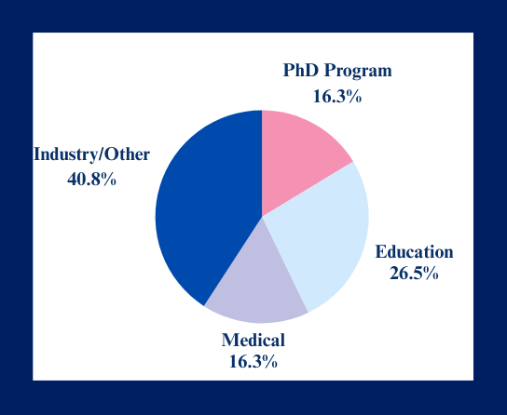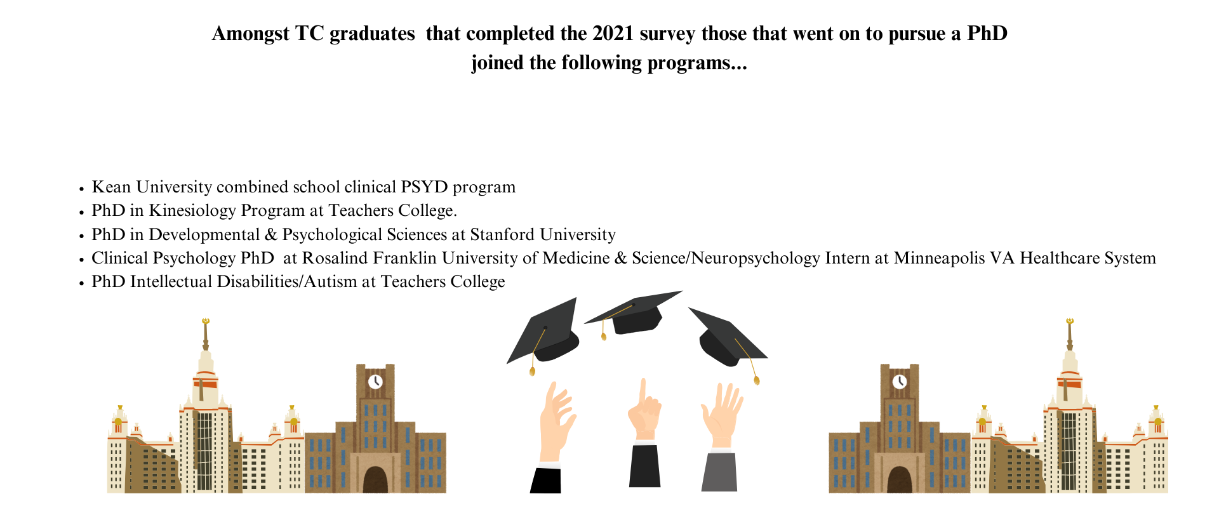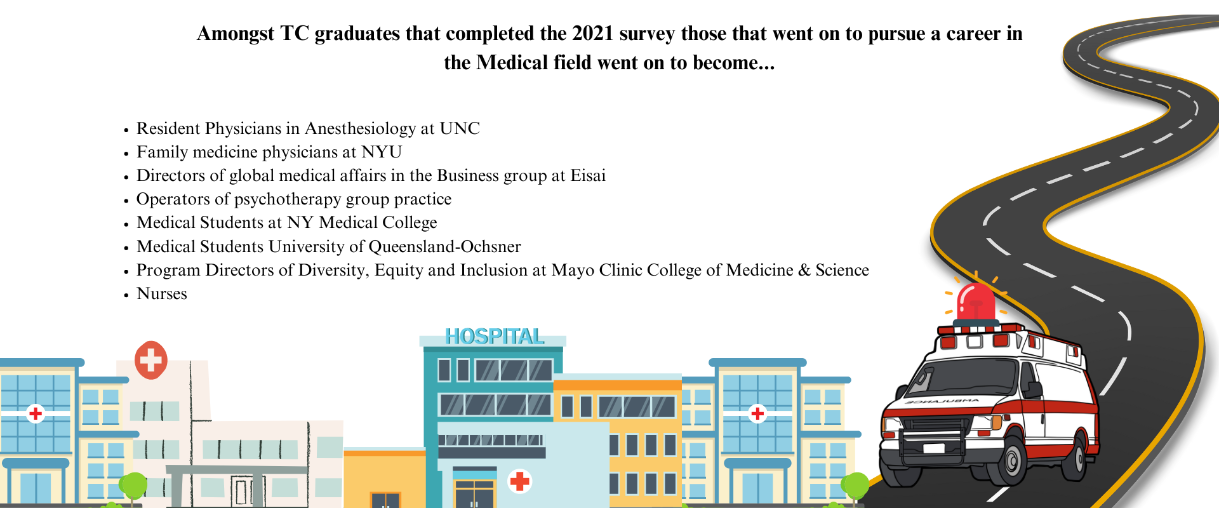Program Information
 Program Guide M.S in Neuroscience & Education
Program Guide M.S in Neuroscience & Education
 Graduation Checklist M.S in Neuroscience & Education
Graduation Checklist M.S in Neuroscience & Education
An overview of key Neuroscience and Education masters Program Information for current students including course prerequisites needed, research opportunities, and graduations requirements.
Neuroscience and Education Masters Course Requirements
1. Core Courses
You must take at least 20 credits within the Neuroscience and Education program (BBSN courses). You can find more information about the in-program courses in the Program Guide. Of these, 15 credits MUST come from the CORE COURSES listed in the Program Guide. Only BBSN 4001 and 4002 offer the opportunity for testing out; only BBSN 4005 offers the opportunity for equivalency from prior coursework. ** To remain in good standing, you must achieve a grade of B or higher in these courses.
2. Cognitive / Psychological Cluster Requirement
You must take AT LEAST 3 CREDITS from the Cognitive and Psychological Neuroscience Cluster, as referenced in the program guide.
3. In-Program Electives
You must take AT LEAST 6 elective credits within the program. Our current elective offerings are listed in the current program guide; these may change from time to time. Also note that any of the courses in the Cognitive / Psychological Cluster above could count as in-program electives, too. Consult with your advisor if you are unsure.
4. Breadth Course Requirement
You must take at least 6 breadth credits. BREADTH COURSES are within Teachers College, but outside of BBSN. For students who do not have substantial background in psychology, statistics or data handling, we recommend that breadth courses are taken in those areas. Suggested breadth courses are listed below. Almost any course outside of the BBSN listings could satisfy the breadth requirement, but there are a few exceptions (also see point #9 below: Excluded Courses). In some cases, instructor permission is required; some courses are limited to students in clinical or teacher training progressions; and some courses are not suited for our program. Always consult with your advisor first.
NOTE: although we check all listings each year, course offerings do change. Please always check current availability through the course schedule search, and consult with your advisor if considering an elective or breadth course not listed here.
5. Additional Credits
For most students, the Core Courses, Cog/Psych Cluster requirement, Electives, plus the Breadth requirement, will add up to 30 credits. This leaves at least 2 more credits to meet the minimum for the degree. These credits can be additional courses from the cog/psych cluster, additional electives, additional breadth courses, or Research / Independent Study credits.
Thesis Requirement
The Thesis, and the Thesis COURSE (BBSN 5500), are both required for graduation. The Thesis Course is graded Pass/Fail. Detailed requirements for the thesis, and guidance and support during the writing process, are provided through the Thesis and Professional Development course (BBSN 5500, 3 credits) which must be taken by every student in their last regular (fall or spring) semester before graduation. The thesis course holds full-time equivalent status at the College. This means that, if you are registered ONLY for the Thesis course in your final semester, you are still considered a full-time student. It also means, importantly, that you are expected to work full time on the research and writing activities that will support your thesis development. The thesis document constitutes a summative assessment, demonstrating your learning throughout the program.
The thesis usually takes one of these forms:
1. A compilation or portfolio, showcasing AT LEAST THREE of the course assignments you have produced during your time in the program. You will write an Introduction, that provides background for the assignments and describes an overarching perspective. Then you will present the three edited assignments themselves, representing knowledge you have gained and developed during the program. Finally, you will write a Discussion section that offers critiques of the work, describes future directions for relevant research, and provides conclusions that relate the presented work back to your Introduction. APA formatting, including comprehensive citations and referencing, are required.
2. An in-depth review of literature pertaining to a specific area of neuroscientific research. We follow established guidelines for literature reviews and seek to conduct replicable, comprehensive, theoretically-grounded reviews that contribute to a deeper understanding of the empirical evidence.
3. In some exceptional circumstances, the thesis can take the form of an empirical report of experimental work. Consult with your thesis director if you are considering this option; their decision is final. Strict criteria must be met for this exception to apply:
• The experimental work should have been undertaken, at least in part, directly by the student. For example, if you have been working in a lab during your program, and have been involved with data collection in an experiment, you may consider an empirical report.
• The student must have the requisite permissions to work with the data. This may require institutional permissions for data sharing, and/or IRB approvals. Consult with the thesis director on your specific circumstances.
Monitor your progress toward your Degree
Degree Audit
The College maintains an online Degree Audit system that gives you a way to monitor your progress towards the degree. You can access your own degree audit through your myTC page. Please check this regularly - it is your MAIN RESOURCE for tracking requirements and progress!
Program Policies
Academic Integrity Policy
All members of our academic community are expected to uphold standards of academic integrity with respect to general conduct, and to avoid engaging in academic misconduct. Academic misconduct includes (but is not limited to) cheating, plagiarism, fabrication of data or information, misrepresentation of records, or the seeking of unfair advantage.
Please ensure that you are familiar with the Teachers College Student Conduct Code:
https://www.tc.columbia.edu/policylibrary/policies/student-conduct-code-academic-integrity-and-general-misconduct-1222590/
Plagiarism and Citation Policy
In our program, we have a zero-tolerance policy for plagiarism. Plagiarism means using someone else’s words or ideas as if they are your own without providing appropriate, clear citation. If any of your instructors detect evidence of plagiarism, they may apply one or more of the following sanctions, at their discretion:
Requiring you to re-do the work; Grading the affected assignment as a zero; Assigning additional work to you; Failing you from the course; and/or Lodging a formal complaint against you that can lead to a Student Conduct Hearing. Student Conduct Hearings may lead to significant sanctions, including but not limited to an official written warning, course or grade failure, academic probation, mandated training, suspension or dismissal from the College, revocation of course credit or a degree. There is some excellent, and accessible, advice about plagiarism here:
Scribendi. (n.d.). How do I know if I’m plagiarizing?
https://www.scribendi.com/academy/articles/how_do_i_know_if_im_plagiarizing.en.html
An important way to avoid plagiarism is to cite your sources. When you write assignments in our program, you are expected to always cite your sources, following APA format. You can find more information about how to appropriately cite and reference your sources here:
https://www.tc.columbia.edu/graduate-writing-center/writing-resources/citing-your-sources/
FAQs about Citation and Referencing
What is the difference between citation and referencing?
Citation and referencing are two distinct components of academic writing. Citation refers to the brief acknowledgment within the text of the sources used. It typically includes the author's last name and the publication year, enclosed in parentheses. For example, Johnson and Lee (2020) or (Yang, 2019). Referencing involves providing detailed information about the sources cited in the text. This information is listed in a Reference List at the end of your document, arranged alphabetically by the authors' last names. The format of a reference list entry varies depending on the source type (e.g., book, journal article, website). Here's an example of referencing for a book:
Yang, P. (2019). The art of writing. TCK Publishing.
A reference list must be included at the end of any submitted assignment, and it should include detailed information about ALL and ONLY the sources directly cited in your work. You can find out more about how to format specific kinds of references here:
https://apastyle.apa.org/style-grammar-guidelines/references
What is the point or purpose of citation?
As scientific writers, we provide evidence from previous work to support our claims and arguments or data. By doing so, we strengthen the credibility of our own work. Citations also allow readers to verify our sources, and allow us to demonstrate the range of sources and perspectives that contributed to and informed our work.
So as you can see, the point of citations and references about acknowledging the researchers who originated the research, ideas or writings. In this sense, citation is something like a copyright. You are acknowledging that your work builds on the ideas and work of others.
Can I cite a paper even if I have not read it?
Yes, if you have derived an idea from that source, then you should cite it. For example, if you are referring to an experiment that you came across in your textbook, cite that paper directly even if you have not read it. Do not cite indirectly via the textbook that you read, or via course lectures.
Is a direct quote from a published paper allowed?
In general, we discourage this practice because we would much rather read your description of ideas. Anyone (or any AI) can copy text. Remember, your assignments during the program are designed to show YOUR understanding and ideas.
The only reason to directly quote a text is if the authors uses wording that specifically pins the ideas very precisely in their own original way. If you do include a direct quote in your work (word for word), then you must set it off in quotation marks and follow this with the author, date and page numbers (if available). But take a look at journal articles to see how often they use direct quotations – not very much!
APA Formatting for Assignments
APA 7 format is expected for all your assignments in the program. In particular, your assignments must accurately apply the principles of citation and referencing, as described above. TC’s Graduate Writing Center offers frequent training on APA format; please check their events page for upcoming dates: https://www.tc.columbia.edu/graduate-writing-center/workshops--events/
Here are some additional online resources on APA format:
The APA website: https://apastyle.apa.org/
TC’s Graduate Writing Center has compiled a whole set of great resources: https://www.tc.columbia.edu/graduate-writing-center/writing-resources/citing-your-sources/
The Online Writing Center (OWL) hosted by Purdue University: https://owl.purdue.edu/owl/research_and_citation/apa_style/apa_formatting_and_style_guide/general_format.html
AI policy
Do not use Chat GPT or any other AI program to write your papers for you. Such abuse is easily spotted and is considered cheating; hence, it will lead to immediate failure on the course, and perhaps other sanctions too (see under “Academic Integrity” above).
While AI is a fascinating new technology, it is essential to understand its limitations. To use it effectively, you need deep knowledge of a field of study to detect when it presents information inaccurately. In the context of your coursework, AI does not have a semantic understanding of the content, which can lead to inaccuracies. Most importantly, this is a critical time to develop your own critical thinking and writing skills. Use this time to work on finding your own voice, rather than relying on AI to speak for you.
In general, a much better strategy than AI to help you organize your materials and ideas, is to check the relevant Wikipedia or Scholarpedia page – written by humans – for your topic, to see what is there (but again, don’t copy it!). Even better would be if you just search for relevant articles in the literature yourself and digest them. Remember, you are here to train as a scientist!
In some of your courses, there are built-in opportunities to work with AI and investigate its strengths and limitations. Make sure you work within the guidelines provided by each professor.
Grading Policy
You can find the Teachers College Grading Policy here:
https://www.tc.columbia.edu/policylibrary/policies/grading-1222549/
Some courses (notably BBSN 5500, the Thesis Course) are graded Pass/Fail only. Each of your instructors makes specific determinations about the grading structure for their own courses, and these may vary; so ensure that you are familiar with the grading rubric that is provided in each course syllabus.
A grade of B or above in Program Core Courses (listed below) is required to maintain academic good standing. The grade of C- is subject to academic review; no more than 3 points of C- may be credited toward any degree, certificate or diploma. Students who accumulate 8 points or more with grades of C- or lower may not continue study at the College and will not receive a degree or diploma.
In general, we all follow this framework:
Letter Grade Typical percentage range Notes
A+ 99 – 100 Exceptional performance. May not be assigned based on extra credit points.
A 93 – 98
A- 90 – 92
B+ 87 – 89
B 83 – 86 Minimum requirement for Program Core
B- 80 – 82
C+ 77 – 79
C 73 – 76
C- 70 – 72 Subject to academic review
F 69 or lower

What Do Graduates Do?
Graduates of the Neuroscience & Education program embark on a wide array of career paths, reflecting the interdisciplinary nature of their training. The program equips them with a unique blend of knowledge in neuroscience, research methodologies, and educational practices, making them highly versatile professionals capable of excelling in various fields.
Below is an overview of some of the many things our alumni are doing now. The breadth of career paths listed below illustrates that the master's in Neuroscience & Education from Teachers College can open doors to a variety of career trajectories. Whether advancing scientific research, contributing to clinical practice, influencing healthcare policy, or contributing to education and industry, graduates are well-prepared to significantly impact various professional arenas. Their diverse roles demonstrate the program's ability to foster adaptable, knowledgeable, and skilled professionals ready to tackle the challenges of today's complex world.





